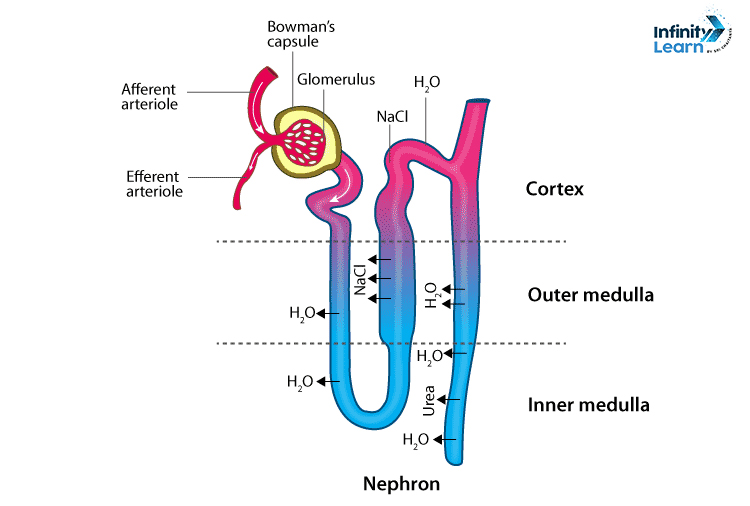Table of Contents
Nephron Diagram Class 10: In a Class 10 nephron diagram, one can observe the structure responsible for filtering waste and balancing fluids in the kidney. Similar to the nucleus in a cell, the nephron acts as the kidney’s processing unit. It filters blood, removing waste and excess substances. The diagram illustrates the renal capsule, a protective layer surrounding the nephron. Inside, there are renal tubules where filtration and reabsorption occur. Additionally, you’ll notice the glomerulus, a tiny ball of blood vessels, and the renal corpuscle, which includes the glomerulus and Bowman’s capsule. This diagram simplifies understanding of how nephrons function in kidney filtration.
What is Nephron
A nephron is a tiny structure found in the kidneys, playing a crucial role in filtering blood and producing urine. It’s like a miniature filtering factory inside the kidney. Each kidney contains thousands of nephrons, and together they help maintain the body’s balance of water, salts, and other substances. Within the nephron, there’s a complex network of tiny blood vessels and tubules. The nephron filters waste products and excess substances from the blood as it flows through. It also reabsorbs essential substances back into the bloodstream. After filtration and reabsorption, the nephron forms urine from the remaining waste. The body then passes this urine out. Essentially, nephrons are the kidney’s microscopic workhorses, ensuring that our blood stays clean and our body stays healthy.
Nephron Diagram for Class 10
A nephron diagram is beneficial for comprehending its structure and functions. This nephron diagram for class 10 helps in grasping how these components collaborate. Throughout this discussion, we’ll dissect each element and its respective function using a nephron diagram.

Components and Functions of the Nephron
The nephron is like a tiny factory in your kidneys that helps keep your blood clean and balanced. It has several important components and functions:
- Glomerulus: Think of it as a sieve. Blood flows into the glomerulus, and its tiny holes filter out waste products and excess substances like water, salts, and glucose.
- Bowman’s Capsule: It’s like a catcher’s mitt. It collects all the filtered stuff from the glomerulus and passes it on to the next part of the nephron.
- Proximal Convoluted Tubule (PCT): In this region, vital substances are reabsorbed back into the bloodstream. These substances include water, glucose, and certain salts. The body retains what it needs.
- Loop of Henle: It’s like a twisty slide. This part helps regulate water balance in your body by reabsorbing more water and salts, making your urine more concentrated.
- Distal Convoluted Tubule (DCT): Here, more fine-tuning happens. Some substances are further reabsorbed or secreted into the urine to keep the balance just right.
- Collecting Duct: It’s like a gathering place. It collects urine from many nephrons and sends it to the ureter, which leads to the bladder for storage until it’s ready to be expelled.
Each part plays a crucial role in keeping your blood clean and your body balanced. If any part isn’t working right, it can lead to problems like kidney disease or imbalances in your body’s fluids and chemicals.
Don’t Miss
- Animal Cell Diagram Class 9
- Human Heart Diagram Class 10
- Neuron Diagram Class 9
- Female Reproductive System Diagram Class 10
- Nucleus Diagram Class 9
Benefits of Nephron Diagram for Class 10
Here are some simple pointers outlining the benefits of using a nephron diagram for a Class 10 student:
- Visual Aid: A nephron diagram provides a visual representation of the structure of the nephron, making it easier for students to understand its complex anatomy.
- Concept Clarification: Seeing the different components of the nephron illustrated in a diagram helps students grasp the concept better than just reading about it in textbooks.
- Memorable Learning: Visuals are often more memorable than text alone. By studying a nephron diagram, students are more likely to remember the structure and function of each part.
- Linking Theory with Reality: A nephron diagram bridges the gap between theoretical knowledge and real-life application, helping students understand how the kidneys work to maintain homeostasis in the body.
- Engagement: Using diagrams in learning can make the topic more engaging and interactive, encouraging active participation and deeper understanding among students.
- Exam Preparation: Understanding the nephron structure through a diagram can aid in exam preparation by facilitating easier recall of information and answering questions related to kidney function.
In summary, using a nephron diagram in Class 10 education provides multiple benefits, including clearer understanding, improved retention of information, and enhanced exam performance.
FAQs on Diagram of Nephron Class 10
What is Nephron with Diagram?
A nephron is the structural and functional unit of the kidney responsible for filtering blood and producing urine. A nephron diagram typically illustrates its components, including the renal corpuscle (glomerulus and Bowman's capsule), proximal convoluted tubule, loop of Henle, distal convoluted tubule, and collecting duct.
Where are Nephrons Located?
Nephrons are located in the kidneys, specifically in the renal cortex and renal medulla.
How do you draw a nephron diagram?
To draw a nephron diagram, start by sketching the renal corpuscle, followed by the proximal convoluted tubule, loop of Henle, distal convoluted tubule, and collecting duct. Label each component accurately to represent their structure and function.
What are the 3 steps of nephron Class 10?
The three main steps of nephron function in Class 10 typically include glomerular filtration, tubular reabsorption, and tubular secretion
Is the nephron diagram important?
Yes, the nephron diagram is important as it helps visualize the structure and function of the nephron, aiding in understanding kidney physiology and the process of urine formation.
What is the structure of nephron class 10?
In Class 10, the structure of a nephron includes the renal corpuscle, proximal convoluted tubule, loop of Henle, distal convoluted tubule, and collecting duct, which work together to filter blood and produce urine.





